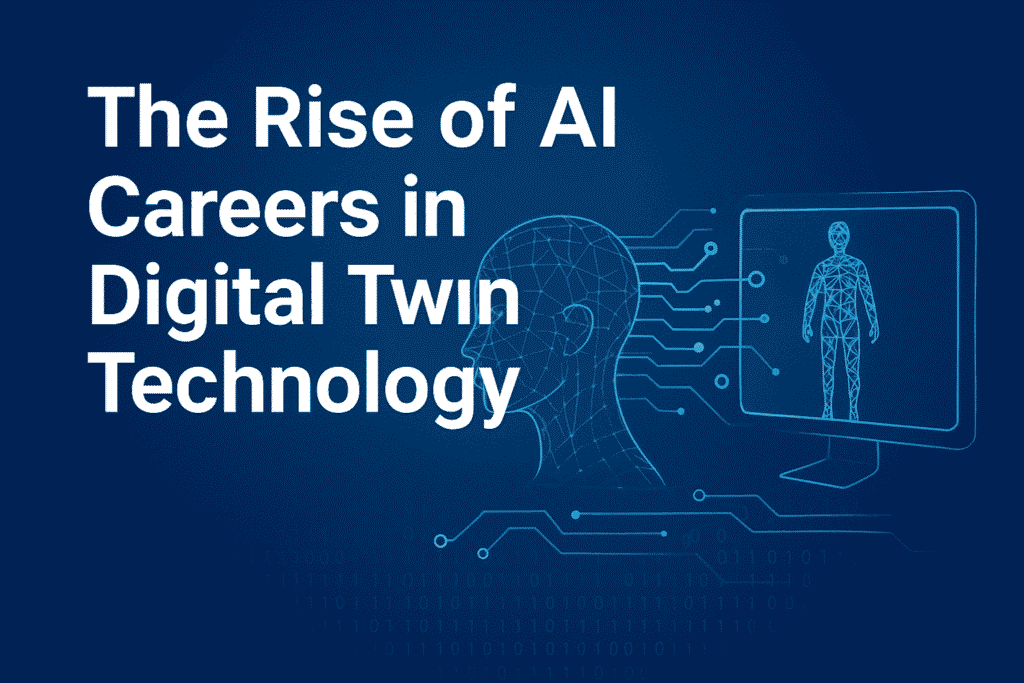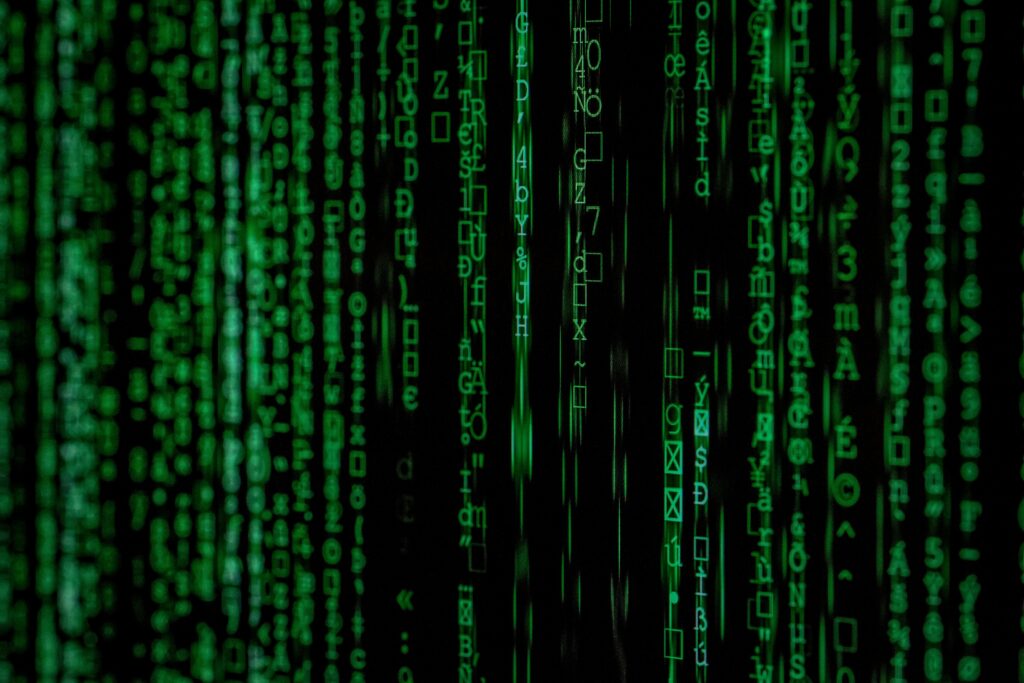1. Introduction: The Convergence of AI and Digital Twin Technology
The modern world is entering an era where every physical system, from a human body to a city, can have a digital replica — a mirror that lives in the virtual world and updates in real-time. This concept, known as Digital Twin Technology, has evolved from an industrial simulation tool into one of the most revolutionary innovations of the 21st century.
When combined with Artificial Intelligence (AI), digital twins transform into intelligent, adaptive systems capable of learning, predicting, and optimizing real-world performance. This synergy is opening vast new frontiers for professionals, engineers, and data scientists, marking the birth of a new generation of careers.
Today, companies across aerospace, healthcare, automotive, manufacturing, energy, and even smart cities are embracing AI-powered digital twins to improve efficiency, safety, and innovation. And with this transformation comes a surge in demand for skilled experts who can design, maintain, and analyze these intelligent virtual counterparts.
In simple terms — AI is the brain, and the digital twin is the body. Together, they represent a new world of possibilities, creating career paths that didn’t even exist a decade ago.
Table of Contents
2. What is Digital Twin Technology?
2.1 The Core Concept
A digital twin is a virtual representation of a physical object, process, or system. It receives real-time data through sensors and IoT (Internet of Things) devices, allowing it to simulate, analyze, and predict performance or failures.
The technology’s roots trace back to NASA’s space program in the 1970s. Engineers created virtual models of spacecraft so that ground control could simulate and resolve issues remotely. This concept evolved, and today, digital twins are used for everything — from simulating aircraft engines to monitoring human hearts.
2.2 The Three Pillars of Digital Twins
- Physical Object or System — The real-world entity being replicated (e.g., a wind turbine, car, or patient).
- Digital Model — The virtual version of that entity, built with real-time data integration.
- Data Connection — The continuous flow of data between the real and virtual systems through IoT sensors and cloud computing.
When powered by AI and machine learning, these components create self-learning systems capable of making intelligent decisions autonomously.

3. How AI Enhances Digital Twins
Digital twins can function without AI, but only as passive data replicas. When AI is integrated, they evolve into predictive, adaptive, and self-improving systems.
Here’s how AI enhances the digital twin ecosystem:
- Predictive Analytics: AI algorithms can forecast equipment failures or process inefficiencies before they occur.
- Behavioral Simulation: Machine learning models can mimic complex human or system behavior under varying conditions.
- Automated Optimization: AI continuously adjusts parameters to maximize performance or efficiency.
- Cognitive Decision-Making: Using natural language processing and reinforcement learning, digital twins can make data-driven decisions independently.
- Scalability: AI enables digital twins to model not just single machines but entire ecosystems — factories, hospitals, or cities.
This marriage of AI and simulation is revolutionizing industries — and creating thousands of high-paying, skill-based jobs in the process.
4. The Evolution of Digital Twins: From Manufacturing to the Metaverse
4.1 Stage 1: Industrial Simulation (2000–2010)
In the early 2000s, digital twins emerged as advanced simulation tools primarily used in aerospace and manufacturing. Companies like Siemens and GE used them to monitor machinery health, predict failures, and optimize maintenance schedules.
4.2 Stage 2: IoT Integration (2010–2020)
The rise of IoT allowed physical devices to transmit real-time data to digital models. This created dynamic, data-rich twins capable of evolving in sync with their real-world counterparts. The focus expanded from machines to processes and entire systems.
4.3 Stage 3: AI-Driven Intelligence (2020–Present)
AI transformed digital twins from reactive systems to predictive, self-learning entities. Machine learning algorithms analyze patterns, identify inefficiencies, and propose solutions without human intervention.
4.4 Stage 4: The Age of Cognitive Twins (Future Trend)
The next evolution — Cognitive Digital Twins — will incorporate emotional and behavioral modeling, allowing systems to simulate human decision-making. This advancement will drive the next big wave of AI careers, blending psychology, ethics, and computational modeling.
5. Real-World Applications of AI-Powered Digital Twins
Digital twins are now used across almost every sector. Let’s look at some key industries leading this revolution and how they’re creating unique career opportunities.
5.1 Healthcare
In healthcare, AI-powered digital twins are revolutionizing personalized medicine. By creating virtual replicas of organs or even entire patients, doctors can simulate treatment outcomes before real procedures.
Examples include:
- Heart digital twins to predict cardiovascular responses.
- Tumor simulations for optimized cancer treatment.
- Genetic modeling for drug compatibility testing.
This is creating new roles like:
- AI Biomedical Simulation Engineer
- Digital Health Data Analyst
- Medical AI Integration Specialist
5.2 Manufacturing and Industry 4.0
Factories use AI digital twins to simulate and optimize production lines, predict maintenance needs, and reduce downtime. AI interprets machine sensor data to ensure maximum productivity.
Key roles:
- Industrial AI Engineer
- Smart Factory Data Scientist
- Predictive Maintenance Analyst
5.3 Automotive and Aerospace
Automotive companies like Tesla, BMW, and Airbus use AI digital twins to monitor vehicles, predict performance, and simulate design changes.
For instance:
- AI twins can simulate how a car performs under extreme temperatures.
- They can predict part wear long before a breakdown occurs.
Career options:
- Vehicle Simulation Engineer
- AI Sensor Data Specialist
- Autonomous Systems Analyst
5.4 Smart Cities
AI and digital twins help governments manage infrastructure efficiently. From traffic management to pollution control, these virtual replicas enable predictive urban planning.
Jobs include:
- Urban Systems Data Analyst
- AI Infrastructure Modeler
- Sustainability Simulation Expert
5.5 Energy and Utilities
Energy providers use AI digital twins to monitor power grids, predict demand, and reduce losses. The integration of renewable energy sources requires highly adaptive systems, making AI crucial.
Key roles:
- Energy Systems Data Engineer
- AI Grid Optimization Specialist
- Renewable Systems Twin Developer
6. The Core Components of an AI-Driven Digital Twin
Understanding the technical foundation of digital twins is vital for those planning a career in this domain.
6.1 Data Collection and IoT Integration
Digital twins depend on accurate, continuous data. IoT devices — such as sensors and wearables — serve as the data bridge between the real and digital worlds.
Skills Required:
- IoT architecture
- Edge computing
- Cloud-based data synchronization
6.2 Machine Learning and AI Algorithms
AI is the core intelligence of digital twins. It enables real-time analysis, predictions, and recommendations.
Common Tools:
- TensorFlow
- PyTorch
- MATLAB
- Scikit-learn
6.3 Simulation and Visualization
3D modeling software like ANSYS, Simulink, and Autodesk allows engineers to visualize physical behavior and run performance simulations.
6.4 Cloud and Edge Computing
Massive computational power is needed to run digital twins efficiently. Hence, expertise in cloud infrastructure (AWS, Azure) and edge AI is essential.
6.5 Cybersecurity and Data Ethics
With sensitive data flowing continuously, AI professionals in this space must ensure data integrity, privacy, and ethical AI governance.
7. Emerging Career Opportunities in AI-Driven Digital Twins
The convergence of AI, IoT, and simulation has created new job titles that blend technical expertise with domain knowledge.
| Job Title | Primary Responsibilities | Key Skills |
|---|---|---|
| AI Simulation Engineer | Builds intelligent simulation models using machine learning to optimize performance and predict outcomes. | ML algorithms, Python, simulation tools |
| Digital Twin Architect | Designs end-to-end digital twin systems for industrial or healthcare applications. | IoT, systems design, cloud computing |
| Predictive Maintenance Specialist | Uses AI to predict and prevent equipment failure. | Data analysis, AI modeling, industrial systems |
| Smart Infrastructure Analyst | Creates and manages digital twins for urban or infrastructure projects. | GIS, AI modeling, sustainability analysis |
| AI Ethics and Compliance Officer | Ensures AI-driven twins operate within ethical and legal boundaries. | Data privacy, AI policy, risk management |
| Biomedical Twin Developer | Builds AI-powered models of human organs or biological systems. | Bioinformatics, AI modeling, medical data |
8. Skills Required for Building a Career in Digital Twin AI
A successful professional in this field needs a hybrid set of technical and analytical skills:
8.1 Technical Skills
- Programming Languages: Python, R, Java, C++
- Machine Learning & Deep Learning: TensorFlow, PyTorch, Keras
- Simulation Tools: MATLAB, ANSYS, SolidWorks
- IoT Systems: Node-RED, MQTT, Azure IoT Hub
- Data Visualization: Power BI, Tableau, Unity
8.2 Analytical & Soft Skills
- Critical thinking and problem-solving
- Cross-domain collaboration
- Communication between engineers, AI teams, and stakeholders
- Ethical reasoning and decision-making
8.3 Educational Background
A career in this field typically requires a degree in:
- Artificial Intelligence
- Computer Science
- Mechanical or Electrical Engineering
- Data Science
- Systems Engineering
However, many professionals transition from non-traditional backgrounds — such as biology, architecture, or business — by learning AI tools and simulation modeling.
9. Salary Trends and Global Career Demand
Digital twin careers offer some of the most competitive salaries in the AI ecosystem. Because the field combines multiple disciplines, the demand far exceeds the current talent supply.
| Role | Average Global Salary (USD) | Experience Level |
|---|---|---|
| AI Simulation Engineer | $95,000 – $140,000 | Mid to Senior |
| Digital Twin Architect | $120,000 – $160,000 | Senior |
| Predictive Maintenance Analyst | $80,000 – $110,000 | Entry to Mid |
| Biomedical Twin Specialist | $100,000 – $150,000 | Mid to Senior |
| Smart City Analyst | $75,000 – $120,000 | Entry to Senior |
| AI Compliance Manager | $90,000 – $130,000 | Mid |
These numbers vary by region, with the U.S., Germany, Singapore, and India being top markets for digital twin professionals.
10. Industries Leading in AI-Driven Digital Twin Adoption
- Aerospace & Defense – Real-time engine simulations (NASA, Boeing).
- Automotive – Vehicle lifecycle monitoring (Tesla, Mercedes-Benz).
- Energy – Smart grid and wind farm optimization (Siemens, GE).
- Healthcare – Patient digital twins and clinical trials.
- Smart Infrastructure – Urban digital twins for planning (Singapore Smart Nation, NEOM).
- Manufacturing – Predictive maintenance and production efficiency (BMW, Rolls-Royce).

11. How AI Powers the Next Generation of Digital Twins
Artificial Intelligence has become the intellectual core of the digital twin ecosystem. While IoT provides the sensory data and cloud computing supplies the infrastructure, AI is what gives digital twins their decision-making and adaptive intelligence.
In traditional simulation systems, engineers had to manually test scenarios. Today, AI algorithms automatically analyze millions of combinations to identify the most efficient and cost-effective outcomes.
Here’s how AI contributes at every layer of a digital twin system:
11.1 Data Processing and Cleaning
AI automates the tedious process of cleaning, validating, and normalizing sensor data before feeding it into simulation models. This ensures that predictions are based on high-quality information rather than noisy data.
11.2 Predictive Modeling
Machine learning algorithms identify trends in historical data to forecast future behavior — predicting when a machine will fail, how a patient will respond to treatment, or how a traffic system will evolve in real time.
11.3 Reinforcement Learning
Reinforcement learning allows digital twins to “learn” optimal decisions through continuous experimentation. For example, a digital twin of an energy grid can learn how to balance power supply and demand efficiently.
11.4 Natural Language Processing (NLP)
In sectors like healthcare or customer service, NLP allows AI-powered twins to understand and respond to human input, bridging the communication gap between machines and people.
11.5 Computer Vision
Digital twins of industrial systems often rely on real-time video feeds. Computer vision AI analyzes these feeds to detect anomalies, quality issues, or safety risks.
By merging all these technologies, AI transforms digital twins from static representations into self-evolving intelligent systems capable of independent operation and optimization.
12. Case Studies: AI-Driven Digital Twins in Action
Let’s explore how some industries are already benefiting from the synergy between AI and digital twin technology — and how these innovations are shaping career landscapes.
12.1 Case Study 1: Siemens Energy
Siemens employs AI-powered digital twins to monitor gas turbines and predict component wear. Their AI system analyzes terabytes of sensor data, forecasting failures months in advance.
This has reduced unplanned downtime by over 30%, saved millions in maintenance costs, and created roles such as:
- AI Maintenance Strategist
- Digital Twin Data Engineer
- Turbine Simulation Specialist
12.2 Case Study 2: Tesla’s Virtual Factory
Tesla uses digital twins of its entire Gigafactory to simulate production lines, optimize resource use, and plan maintenance.
Machine learning models continuously analyze assembly line efficiency, leading to near-zero downtime.
New career roles include:
- Smart Factory Automation Engineer
- AI Production Data Analyst
- Simulation Control Architect
12.3 Case Study 3: Philips Healthcare
Philips is pioneering patient digital twins that help doctors simulate treatment outcomes. AI analyzes patient vitals, genetic data, and medical history to suggest personalized treatment paths.
This has created opportunities for:
- Medical Data Simulation Scientist
- AI Clinical Researcher
- Digital Health Systems Engineer
12.4 Case Study 4: Singapore’s Smart Nation Project
Singapore’s government built a nationwide urban digital twin, powered by AI, to simulate traffic, waste management, and climate effects.
AI algorithms predict congestion, model flood risks, and even simulate population growth.
Roles created:
- Urban Data AI Analyst
- Smart City Model Developer
- Sustainability Optimization Engineer
13. The Role of AI in Predictive and Prescriptive Analytics
Predictive and prescriptive analytics are the two pillars of decision-making within digital twin ecosystems.
- Predictive Analytics answers what will happen by analyzing trends and anomalies.
- Prescriptive Analytics answers what should we do by recommending optimal actions.
13.1 Predictive Analytics in Manufacturing
AI predicts when a machine will fail, allowing maintenance before breakdown. This is known as predictive maintenance and is one of the most in-demand AI applications globally.
13.2 Prescriptive Analytics in Smart Energy Systems
AI-driven digital twins can recommend how to balance renewable energy sources with traditional power grids, reducing costs and emissions.
13.3 Predictive Patient Modeling in Healthcare
By integrating deep learning with patient digital twins, AI predicts how individuals will react to drugs, helping to avoid adverse effects.
These applications aren’t just saving costs—they are creating new jobs that combine data analytics, ethics, and domain expertise.
14. Table: AI-Powered Job Roles in Digital Twin Ecosystems
| Job Role | Primary Function | Key Technologies Used | Average Global Salary (USD) |
|---|---|---|---|
| AI Twin Engineer | Builds self-learning models for digital twins | Python, TensorFlow, IoT | $95,000 – $140,000 |
| Predictive Maintenance Analyst | Prevents system breakdowns using AI data | Scikit-learn, MLFlow, Azure AI | $80,000 – $110,000 |
| Simulation Architect | Designs virtual systems for industrial and healthcare environments | MATLAB, ANSYS, SolidWorks | $110,000 – $160,000 |
| Digital Operations Scientist | Manages AI-powered twin operations | Power BI, AWS, Databricks | $90,000 – $130,000 |
| Ethical AI Officer | Ensures fairness and compliance in AI models | Explainable AI, Policy, Law | $100,000 – $140,000 |
15. Ethical and Legal Considerations in Digital Twin Careers
With massive data exchange between physical and virtual systems, ethical and legal concerns are growing.
Professionals in this field must address three critical dimensions:
15.1 Data Privacy
Digital twins in healthcare or smart cities handle personal data, making compliance with GDPR and HIPAA essential. AI specialists must design models that protect sensitive information through encryption and anonymization.
15.2 Algorithmic Transparency
As AI becomes more autonomous, explainable AI (XAI) ensures that decisions can be traced and justified. This is vital in industries like healthcare or aviation, where accountability matters.
15.3 Environmental Responsibility
Running AI simulations consumes energy. The next generation of AI professionals will focus on creating green AI frameworks that reduce computational energy consumption.
This means AI ethics is no longer an optional skill — it’s a core competency in digital twin careers.

16. The Interdisciplinary Nature of Digital Twin Careers
Unlike traditional technology roles, digital twin careers require professionals who can bridge multiple domains — engineering, data science, and business strategy.
Let’s break down the cross-disciplinary skill sets needed:
| Domain | Skills Needed | Career Paths |
|---|---|---|
| Engineering | CAD modeling, physics simulation | Mechanical/Aerospace Engineer, Twin Modeler |
| Data Science | ML, AI, predictive analytics | AI Analyst, Data Engineer |
| Business & Strategy | Cost optimization, process modeling | Operations Consultant, Digital Strategy Advisor |
| Ethics & Law | AI compliance, responsible design | Policy Expert, AI Governance Officer |
This hybrid approach makes digital twin professionals some of the most valuable in the AI-driven economy.
17. Education and Certifications to Get Started
17.1 Academic Background
A strong foundation in computer science, AI, or engineering is ideal. However, many universities now offer specialized courses such as:
- M.Sc. in Digital Twin Engineering
- M.Tech. in AI and IoT Integration
- Postgraduate Diploma in Simulation Science
17.2 Industry Certifications
These certifications are recognized globally and can accelerate your career:
- Siemens Digital Twin Certification
- IBM AI Engineer Professional Certificate
- AWS IoT and AI Specialization
- Coursera’s Digital Twin Fundamentals
- Microsoft Azure AI Engineer Associate
17.3 Open-Source Learning Platforms
To stay updated, learners can explore:
- Kaggle for AI-based simulation challenges
- GitHub repositories for open digital twin projects
- Google Colab for hands-on model training
18. The Rise of Digital Twin Startups
AI-driven digital twin startups are growing exponentially, opening roles for both tech and non-tech professionals.
18.1 Emerging Startups to Watch
- CityZenith (U.S.) – Smart city twins for sustainable infrastructure.
- Twinify (Germany) – Industrial digital twins using reinforcement learning.
- Unlearn.AI (U.S.) – Digital twin simulations for clinical trials.
- Plexus (India) – AI-based predictive manufacturing twins.
- MindTwin (Global) – Personal digital twin assistants for emotional modeling.
Each of these companies offers career paths ranging from AI data engineers to simulation designers and product strategists.
18.2 Investment and Market Growth
According to MarketsandMarkets, the global digital twin market is expected to reach USD 155 billion by 2030, growing at a CAGR of 36%.
This expansion will create millions of new jobs, with AI integration at the core of nearly every one.
19. Challenges Facing AI in Digital Twin Systems
Even with remarkable progress, there are significant hurdles professionals must address.
19.1 Data Overload
Massive sensor data can overwhelm systems. AI specialists must learn to build efficient data pipelines and use edge AI to minimize cloud dependency.
19.2 Lack of Standardization
Different industries use different data formats and modeling standards. AI engineers will play a key role in developing interoperable frameworks.
19.3 Cybersecurity Threats
Since digital twins are connected to real systems, hacking can lead to physical damage. AI-based security models using anomaly detection will be crucial.
19.4 Ethical Misuse
As AI twins simulate people and systems, ethical misuse (e.g., creating human replicas without consent) must be prevented through strict legal frameworks.
20. The Human Side of Digital Twins: Emotional and Cognitive Replication
Beyond machines and systems, AI-driven digital twins are beginning to simulate human behavior. This emerging area — known as Cognitive Digital Twins — is set to redefine human–machine interaction.
These twins can replicate human emotions, decision patterns, and memory, helping industries like healthcare, education, and entertainment personalize services.
Future Job Roles Emerging in This Field:
- Cognitive Twin Developer
- Emotion AI Researcher
- Human Behavior Simulation Analyst
- AI Personality Model Designer
This is where digital twin careers begin to overlap with AI psychology and human-centered computing, making it one of the most future-proof domains of the decade.
7. The Convergence of AI and Digital Twins Across Industries
The real-world adoption of digital twin technology has rapidly moved beyond traditional manufacturing and infrastructure. With the integration of artificial intelligence, these virtual replicas are evolving into powerful predictive systems that not only simulate but also learn and adapt over time.
Let’s explore some key sectors where AI-driven digital twins are redefining operations, improving safety, and opening new career opportunities.
7.1 Healthcare: From Patient Twins to Predictive Medicine
In healthcare, digital twins are being developed to represent the physiological and behavioral data of patients. These AI-enhanced models can forecast how an individual might respond to a particular drug, lifestyle change, or surgery.
For example, Siemens Healthineers and Philips are already building “patient digital twins” that can simulate organ-level processes such as heart rhythm or lung performance.
AI plays a critical role in processing vast biomedical data, identifying patterns invisible to the human eye, and making recommendations for preventive care.
This convergence is leading to new roles such as:
- AI Medical Modeler
- Health Data Integration Engineer
- Clinical Simulation Specialist
These professionals must possess hybrid skills in biology, data science, and ethical AI deployment, as human health data is among the most sensitive and complex domains in existence.
7.2 Smart Cities and Infrastructure
Urban planning is another major beneficiary of AI-driven digital twin technology. City-scale twins can model traffic, pollution, waste management, and even emergency response.
For instance, Singapore’s “Virtual Singapore” initiative represents a full-scale digital twin of the city, integrating real-time data on traffic, public health, and building energy efficiency.
AI enables these systems to autonomously optimize transport routes, predict infrastructure failures, and plan emergency responses.
Career opportunities here include:
- Urban Systems Data Scientist
- Smart Infrastructure Engineer
- AI Policy Advisor for City Governance
Professionals in these roles help ensure that cities become sustainable, resilient, and people-centric, balancing innovation with privacy and inclusivity.
7.3 Aerospace and Defense
In aerospace, digital twins are now critical to design, testing, and maintenance. Boeing and Rolls-Royce use AI-driven digital twins to simulate aircraft engine performance under various atmospheric conditions. These systems reduce physical testing costs and enhance reliability by predicting component wear and system failure before they occur.
AI experts in this field often work alongside aerospace engineers to optimize flight data, improve aerodynamics, and strengthen predictive maintenance algorithms.
Emerging roles include:
- Aerospace AI Simulation Analyst
- Digital Twin Flight Systems Engineer
- Predictive Maintenance Data Engineer
These roles are well-paid, with salaries ranging between ₹12–40 LPA in India and $100K–$180K USD in global markets, depending on experience and expertise.
7.4 Automotive and Mobility
The automotive sector, especially in the age of electric and autonomous vehicles, has embraced digital twins to model battery performance, vehicle behavior, and user experience.
Tesla, BMW, and Mercedes-Benz employ AI-driven twins for predictive diagnostics, energy optimization, and fleet management.
With AI and IoT integration, vehicles are becoming “moving data centers.” They constantly exchange information with their digital replicas to monitor tire wear, engine health, and environmental impact.
Prominent job roles here include:
- Vehicle Data Scientist
- EV Battery Simulation Engineer
- Autonomous System Modeler
This intersection of AI, IoT, and mobility is a rapidly expanding domain, attracting professionals skilled in both software and mechatronics.
8. The Role of Ethics and Data Privacy in Digital Twin Careers
As AI-driven digital twins grow in complexity, so do the ethical dilemmas they pose. These systems collect and analyze large amounts of personal, industrial, or even national data — leading to heightened concerns about consent, surveillance, and misuse.
8.1 Data Ownership and Transparency
Who owns the data generated by a digital twin?
For instance, in healthcare, if a hospital builds a digital twin of a patient’s body using sensor data, should the hospital, the patient, or the technology provider have control over it?
AI professionals in this field must be well-versed in frameworks such as GDPR (General Data Protection Regulation) and India’s DPDP (Digital Personal Data Protection) Act.
This opens up roles like:
- AI Ethics Consultant
- Data Governance Officer
- Compliance Engineer for Digital Ecosystems
8.2 Bias and Fairness
AI systems, if not properly trained, can amplify existing biases. A digital twin trained on biased datasets could lead to discriminatory outcomes — for example, recommending less maintenance for vehicles used in developing regions, or predicting healthcare outcomes less accurately for certain populations.
Therefore, data diversity and transparency have become key hiring requirements for companies adopting AI-driven digital twins.
8.3 Accountability and Explainability
When an AI-driven twin makes an autonomous decision — such as shutting down an industrial system or flagging a health emergency — who is held responsible if something goes wrong?
This introduces the concept of Explainable AI (XAI), where algorithms must justify their decisions in human-understandable terms.
AI compliance and accountability roles are among the fastest-growing subfields in this ecosystem.
9. Educational Pathways for a Career in AI-Driven Digital Twin Technology
If you’re planning a career in this field, the good news is that it’s accessible through multiple educational routes — from traditional engineering backgrounds to new interdisciplinary programs.
9.1 Academic Qualifications
To begin, you’ll need at least a bachelor’s degree in one of the following areas:
- Computer Science or AI Engineering
- Mechanical or Electrical Engineering
- Data Science and Machine Learning
- Mechatronics
- Industrial Automation
For senior roles, pursuing a Master’s in AI, Robotics, or Digital Systems Simulation can open pathways to advanced research and leadership roles.
9.2 Specialized Certifications
Here are some certifications that can strengthen your profile:
- IBM Digital Twin Developer Certificate
- Microsoft Certified: Azure AI Engineer Associate
- Siemens PLM Digital Twin Professional
- Coursera’s AI in Manufacturing Specialization
- NVIDIA Deep Learning and Simulation Programs
These certifications validate your skills in simulation software, AI modeling, and integration frameworks.
9.3 Technical Skills to Focus On
| Category | Key Skills Required |
|---|---|
| AI & Data Science | Machine Learning, Deep Learning, Predictive Analytics |
| Simulation Tools | MATLAB, Ansys, Simulink, Dassault Systèmes |
| Programming Languages | Python, R, C++, TensorFlow, PyTorch |
| IoT Integration | Edge Computing, MQTT, Sensor Network Design |
| Cloud & DevOps | AWS IoT TwinMaker, Azure Digital Twins, Docker, Kubernetes |
Developing fluency in both AI and industrial simulation platforms gives professionals a strong competitive edge in this interdisciplinary domain.
10. Global Demand and Career Outlook
The demand for AI professionals in digital twin technology is projected to grow exponentially.
According to Gartner, over 70% of industrial enterprises will be using digital twins by 2030, and the integration of AI will make these systems even more autonomous and intelligent.
10.1 Salary Insights
| Job Role | Average Salary (India) | Average Salary (US) |
|---|---|---|
| Digital Twin Engineer | ₹10–25 LPA | $95,000–$150,000 |
| AI Simulation Scientist | ₹12–30 LPA | $110,000–$160,000 |
| IoT Systems Architect | ₹14–28 LPA | $120,000–$180,000 |
| Predictive Maintenance Engineer | ₹8–18 LPA | $90,000–$130,000 |
| Data Integration Specialist | ₹7–15 LPA | $85,000–$120,000 |
These salaries are projected to rise steadily as digital twin technology becomes mainstream in manufacturing, energy, healthcare, and aerospace.
11. Research and Academic Contributions
Top universities and research labs worldwide are contributing heavily to AI-powered digital twin innovation. Institutions such as MIT, Stanford, and the Indian Institute of Science (IISc) have launched projects focusing on energy-efficient simulation, intelligent control systems, and ethics in autonomous modeling.
Collaborations between academia and industry — such as Siemens Xcelerator Lab and GE Digital Twin Research Center — are producing next-generation tools that merge physical modeling with cognitive AI.
Researchers with backgrounds in applied AI, physics, and simulation modeling have abundant opportunities to shape the theoretical foundations of the field.
12. Entrepreneurship and Startup Opportunities
The rise of digital twins has opened vast potential for entrepreneurs. Startups are building domain-specific AI twin solutions — from smart grids to wearable devices.
For example:
- Cityzenith focuses on urban infrastructure modeling.
- Ansys Twin Builder provides enterprise-grade simulation tools.
- Twin Health uses AI-powered digital twins for metabolic health monitoring.
Entrepreneurs can leverage open-source platforms like OpenTwin or Azure Digital Twins API to create affordable solutions tailored to SMEs and developing economies.

13. The Future: Towards a Fully Cognitive Twin Ecosystem
As we look toward 2035, the future of digital twins will evolve into cognitive twins — systems capable of continuous learning and autonomous decision-making. These twins will not only reflect reality but also predict and optimize it in real-time.
AI will drive self-learning feedback loops that make industries faster, safer, and more sustainable.
For professionals, this means working on challenges at the intersection of human cognition, automation, and data ethics.
Tomorrow’s digital twin workforce will consist of professionals who understand both machines and meaning — engineers who can code empathy into systems, and data scientists who can model trust.
14. Conclusion: The Human Element in Intelligent Mirroring
While digital twin technology thrives on sensors, data, and computation, its true potential emerges when combined with human insight. AI enables these systems to think, but it is human creativity and ethical judgment that ensure they serve society responsibly.
The careers emerging from this synergy — from AI-driven system modelers to simulation strategists — represent the future of intelligent industry.
As AI continues to evolve, those who can bridge technology and empathy will define the next era of innovation.
In this journey toward a connected, mirrored world, digital twins stand as proof that intelligence — whether human or artificial — is most powerful when it learns to reflect, adapt, and care.
follow us on whatsapp channel

















